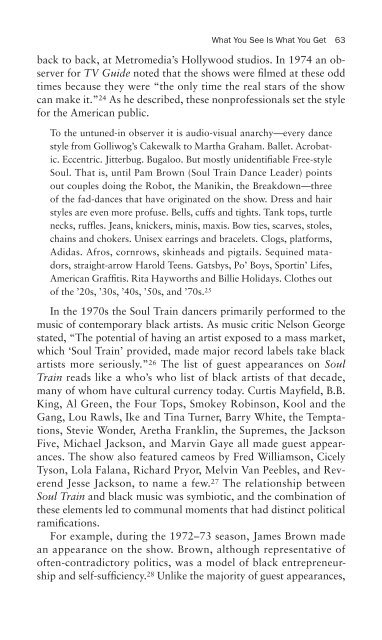Revolution Televised.pdf
Revolution Televised.pdf
Revolution Televised.pdf
Create successful ePaper yourself
Turn your PDF publications into a flip-book with our unique Google optimized e-Paper software.
What You See Is What You Get 63<br />
back to back, at Metromedia’s Hollywood studios. In 1974 an observer<br />
for TV Guide noted that the shows were filmed at these odd<br />
times because they were “the only time the real stars of the show<br />
can make it.” 24 As he described, these nonprofessionals set the style<br />
for the American public.<br />
To the untuned-in observer it is audio-visual anarchy—every dance<br />
style from Golliwog’s Cakewalk to Martha Graham. Ballet. Acrobatic.<br />
Eccentric. Jitterbug. Bugaloo. But mostly unidentifiable Free-style<br />
Soul. That is, until Pam Brown (Soul Train Dance Leader) points<br />
out couples doing the Robot, the Manikin, the Breakdown—three<br />
of the fad-dances that have originated on the show. Dress and hair<br />
styles are even more profuse. Bells, cuffs and tights. Tank tops, turtle<br />
necks, ruffles. Jeans, knickers, minis, maxis. Bow ties, scarves, stoles,<br />
chains and chokers. Unisex earrings and bracelets. Clogs, platforms,<br />
Adidas. Afros, cornrows, skinheads and pigtails. Sequined matadors,<br />
straight-arrow Harold Teens. Gatsbys, Po’ Boys, Sportin’ Lifes,<br />
American Graffitis. Rita Hayworths and Billie Holidays. Clothes out<br />
of the ’20s, ’30s, ’40s, ’50s, and ’70s. 25<br />
In the 1970s the Soul Train dancers primarily performed to the<br />
music of contemporary black artists. As music critic Nelson George<br />
stated, “The potential of having an artist exposed to a mass market,<br />
which ‘Soul Train’ provided, made major record labels take black<br />
artists more seriously.” 26 The list of guest appearances on Soul<br />
Train reads like a who’s who list of black artists of that decade,<br />
many of whom have cultural currency today. Curtis Mayfield, B.B.<br />
King, Al Green, the Four Tops, Smokey Robinson, Kool and the<br />
Gang, Lou Rawls, Ike and Tina Turner, Barry White, the Temptations,<br />
Stevie Wonder, Aretha Franklin, the Supremes, the Jackson<br />
Five, Michael Jackson, and Marvin Gaye all made guest appearances.<br />
The show also featured cameos by Fred Williamson, Cicely<br />
Tyson, Lola Falana, Richard Pryor, Melvin Van Peebles, and Reverend<br />
Jesse Jackson, to name a few. 27 The relationship between<br />
Soul Train and black music was symbiotic, and the combination of<br />
these elements led to communal moments that had distinct political<br />
ramifications.<br />
For example, during the 1972–73 season, James Brown made<br />
an appearance on the show. Brown, although representative of<br />
often-contradictory politics, was a model of black entrepreneurship<br />
and self-sufficiency. 28 Unlike the majority of guest appearances,

















